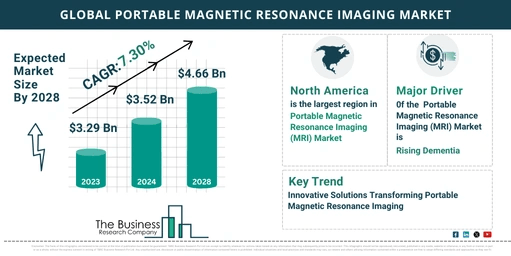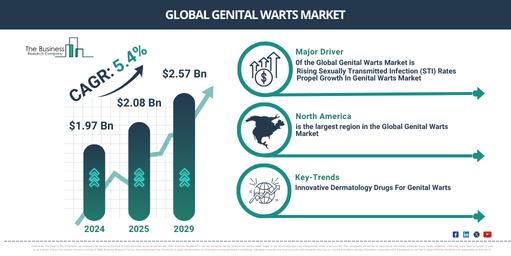Top 5 Insights From The Portable Magnetic Resonance Imaging (MRI) Market Report 2024
The Business Research Company’s global market reports are now updated with the latest market sizing information for the year 2024 and forecasted to 2033
According to The Business Research Company’s Portable Magnetic Resonance Imaging (MRI) Global Market Report 2023, the portable magnetic resonance imaging (MRI) market is expected to show promising growth in the forecast period.
Overview of Market Growth
- Market Expansion: The portable magnetic resonance imaging (MRI) market has seen significant growth, increasing from $3.29 billion in 2023 to $3.52 billion in 2024 at a CAGR of 7.0%.
- Future Projections: The market is projected to reach $4.66 billion by 2028, growing at a CAGR of 7.3%.
- Key Growth Drivers:
- Increasing prevalence of neurological disorders.
- Rising demand for point-of-care diagnostics.
- Advancements in battery technology and image resolution.
View More On The Portable Magnetic Resonance Imaging (MRI) Market Report 2024 –
https://www.thebusinessresearchcompany.com/report/portable-magnetic-resonance-imaging-mri-global-market-report
Factors Driving Market Expansion
- Rising Dementia Cases:
- Increasing Prevalence: The global aging population and improved diagnostic capabilities are leading to a rise in dementia cases, driving the need for portable MRI solutions.
- Role of Portable MRI: Portable MRI devices enable on-site brain imaging to assess structural changes and aid in diagnosing and monitoring dementia, particularly in clinics and care facilities.
- Case Example: In 2023, the Australian Institute of Health and Welfare reported that approximately 411,100 Australians had dementia, a figure expected to more than double by 2058, underscoring the growing demand for portable MRI technology.
- Innovative Technological Solutions:
- Mobile MRI Scanners: Companies are developing mobile MRI scanners to enhance accessibility and flexibility in medical imaging, particularly for remote and underserved areas.
- Example: Siemens Healthineers launched the MAGNETOM Viato.Mobile, a 1.5 Tesla mobile MRI scanner optimized for easy transportation to offsite locations, making advanced imaging technology accessible to patients who would otherwise need to travel long distances.
Market Segmentation and Key Players
- Product Segmentation:
- Superconducting-Magnet-Based Portable MRI.
- Electromagnet-Based Portable MRI.
- Permanent-Magnet-Based Portable MRI.
- Applications:
- Neurology.
- Musculoskeletal.
- Gastroenterology.
- Other Applications.
- End Users:
- Hospitals.
- Diagnostic Centers.
- Ambulatory Surgery Centers.
- Other End Users.
- Major Companies:
- TATA Group, Siemens Healthineers AG, Koninklijke Philips N.V.
- Alliance HealthCare Services Inc., Akumin Inc., Esaote SpA.
- Hyperfine Inc., Burgess Diagnostics Ltd, Interim Diagnostic Imaging Ltd.
- Kings Medical Group Inc., Aurora Imaging Technology Inc.
Strategic Acquisitions and Market Expansion
- Acquisition for Market Expansion:
- Modular Devices Acquires Interim Diagnostic Imaging: In April 2023, Modular Devices Inc. acquired Interim Diagnostic Imaging, significantly enhancing its mobile imaging capabilities. This acquisition allows Modular Devices to expand its offerings in mobile MRI, CT, and other imaging solutions, providing comprehensive services to healthcare teams nationwide.
Trends Shaping the Future of Portable MRI
- Artificial Intelligence and Machine Learning:
- AI and machine learning algorithms are expected to play a significant role in improving image resolution and diagnostic accuracy, further driving the adoption of portable MRI systems.
- Integration with Other Imaging Modalities:
- Integration with other imaging technologies like ultrasound and CT scans is anticipated, offering a more comprehensive diagnostic approach and improving patient outcomes.
- Cost Reduction and Reimbursement Policies:
- As technology advances and production scales up, the cost of portable MRI systems is expected to decrease, making them more accessible to a broader range of healthcare providers. Favorable reimbursement policies will also support market growth.
- Patient-Specific Imaging Protocols:
- The development of patient-specific imaging protocols will enhance the precision of diagnostics and treatment planning, particularly in complex cases like cancer detection and treatment response monitoring.
Regional Insights
- North America: North America was the largest region in the portable MRI market in 2023, driven by advanced healthcare infrastructure and high adoption rates of portable imaging technologies.
- Asia-Pacific: The Asia-Pacific region is expected to be the fastest-growing market during the forecast period, fueled by expanding healthcare infrastructure, rising healthcare expenditure, and increasing awareness of early diagnosis.
Conclusion
The portable magnetic resonance imaging (MRI) market is on a strong growth trajectory, driven by technological advancements, increasing demand for point-of-care diagnostics, and the rising prevalence of neurological disorders like dementia. With innovations in mobile MRI technology and strategic acquisitions, the industry is well-positioned to meet the growing demand for accessible and cost-effective imaging solutions, particularly in underserved regions. As the market continues to evolve, trends such as AI integration, cost reduction, and patient-specific protocols will further enhance the capabilities and adoption of portable MRI systems.
Request A Sample Of The Global Portable Magnetic Resonance Imaging (MRI) Market Report 2024:
https://www.thebusinessresearchcompany.com/sample_request?id=16769&type=smp



